老鼠记者第二本历史知识Egyptian Gods and Goddesses
2019-12-25 13:34:43
老鼠记者第二本Chapter 16: Bastet, the Cat Goddess 列出了一些古埃及的神。
咱们来了解一下这些神。
Egyptian Gods and Goddesses
1. Atum: The creator god
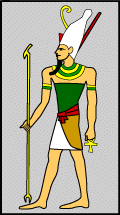
The ancient Egyptians believed that Atum was the first god to exist on earth. They believed that Atum rose from the waters of chaos (Nun) and created all the gods.
In the beginning, there was nothing (Nun). A mound of earth rose from Nun and upon it Atum created himself. He spat Shu (air) and Tefnut (moisture) from his mouth. Atum’s two offspring became separated from him and lost in the dark nothingness, so Atum sent his “Eye” to look for them (a precursor to the “Eye of Ra”, an epithet given to many deities at different times). When they were found, he named Shu as “life” and Tefnut as “order” and entwined them together.
Atum became tired and wanted a place to rest, so he kissed his daughter Tefnut, and created the first mound (Iunu) to rise from the waters of Nun. Shu and Tefnut gave birth to the earth (Geb) and the sky (Nut) who in turn give birth to Osiris, Isis, Set, Nephthys, and Horus the elder.
2. Anubis: the god of embalming and the dead
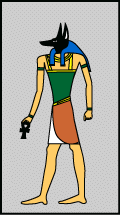
Since jackals were often seen in cemeteries, the ancient Egyptians believed that Anubis watched over the dead. Anubis was the god who helped to embalm Osiris after he was killed by Seth. Thus, Anubis was the god who watched over the process of mummifying people when they died. Priests often wore a mask of Anubis during mummification ceremonies.
Anubis was initially related to the Ogdoad of Hermopolis, as the god of the underworld. In the Pyramid Texts of Unas, Anubis is associated with the Eye of Horus who acted as a guide to the dead and helped them find Osiris. In other myths, Anubis and Wepwawet (Upuaut) led the deceased to the halls of Ma´at where they would be judged. Anubis watched over the whole process and ensured that the weighing of the heart was conducted correctly. He then led the innocent on to a heavenly existence and abandoned the guilty to Ammit.
The ancient Egyptians believed that the preservation of the body and the use of sweet-smelling herbs and plants would help the deceased because Anubis would sniff the mummy and only let the pure move on to paradise. According to early myths, Anubis took on and defeated the nine bows (the collective name for the traditional enemies of Egypt) gaining a further epithet “Jackal ruler of the bows”.
The growing power of the Ennead of Heliopolis resulted in the merging of the two religious systems. However, Osiris was the King of the Underworld in the Ennead and he was more popular (and powerful) than Anubis. So Anubis was relegated to a god of mummification. Anubis was still closely involved in the weighing of the heart but was more a guardian than a ruler.
3. Osiris: the god of the dead, and ruler of the underworld
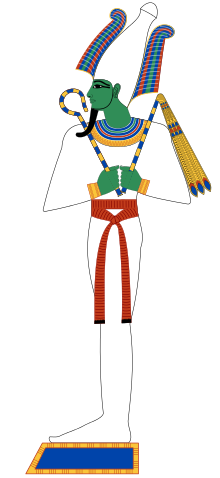
Osiris was the brother/husband of Isis, and the brother of Nephthys and Seth. He was also the father of Horus. As well as being a god of the dead, Osiris was a god of resurrection and fertility. In fact, the ancient Egyptians believed that Osiris gave them the gift of barley, one of their most important crops.
The oldest religious texts known to us refer to him as the great god of the dead, who once possessed human form and lived upon earth. After his murder by Set he became the king of the underworld and presided over the judgment of dead souls. As Osiris had been a good and beneficent ruler during his lifetime, his presence in the underworld no doubt gave the people great comfort.
The myth of Osiris and Isis
Set had been jealous of his brother Osiris’ power and popularity for some time. When Osiris decided to travel the world to bring civilization to its people, he made Isis Regent of Egypt instead of Set. This was the last straw. Set was strong and brave (he was not two-dimensionally “evil”) but he had a terrible temper and he vowed to kill his brother and take the power he considered to be rightfully his. Set invited Osiris to a banquet and had a beautiful cedarwood and ebony chest made just for the occasion. He offered the chest to anyone who could fit into it. Just as Set planned, none of the other guests fitted the chest perfectly, the only person left to try was Osiris. When he lay down in the chest (which had been made to fit him), Set slammed on the lid and nailed it down. He sealed it with molten led and threw it in the Nile.
The chest was swept out to sea and landed on the coast near Byblos. The instant it touched the land, a huge Tamarisk tree sprouted up to protect it. The tree grew so large that the king of Byblos trimmed it and set it up as a pillar in his palace. Isis tracked his body to Byblos and persuaded the king to give it to her (by saving a child from a snake bite – easy for the “queen of heaven”). She took her husband’s corpse back to Egypt and used magic to conceive his child, Horus (other accounts suggest she was already pregnant when he died). However, Set found Osiris’s body unattended while Isis took the infant Horus to be cared for by Wadjet (or Udjat, “she who is green”, the cobra goddess of Lower Egypt).
He cut the corpse into fourteen (or sixteen) parts and distributed them around Egypt. Isis was distraught, and enlisted the help of her sister (and Set’s wife) Nephthys. They found all but one of the pieces. Isis and Nephthys mourned over the dead body of their brother and Ra took pity on them. He sent Anubis to prepare Osiris for the first-ever mummification and instructed Thoth, Isis, and Nephthys to piece the body back together. Isis transformed into a kite (common small bird) and breathed life into him, but it was not sufficient for him to take his place with the living. Instead, he travelled to the underworld, a seemingly dark and desolate place. But Re reassured him that he would find peace and contentment as the king of the dead, and his son Horus would rule over the living.
4. Isis: Wife of Osiris and mother of Horus
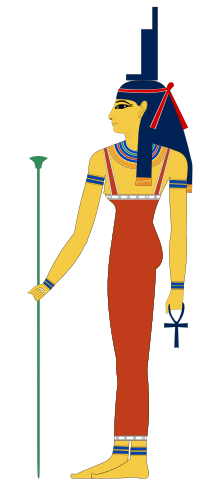
Isis was a protective goddess. She used powerful magic spells to help people in need. Since each pharaoh was considered the 'living Horus', Isis was very important. Isis is often shown holding Horus on her lap. Isis is associated with thrones because her lap was the first 'throne' that Horus sat upon.
Isis was her Greek name, but she was known to the ancient Egyptians as Aset (or Ast, Iset, Uset), which is usually translated as “(female) of throne” or “Queen of the throne”.
The Egyptians highly valued family life and Isis was the paragon of motherly virtues. From the New Kingdom, Isis was considered to be the archetypal mother and was a patron goddess of childbirth and motherhood. As Horus was the patron of the living Pharaoh, Isis could be described as the mother of the Pharaoh. The image of Isis and the infant Horus was extremely popular in Egyptian art and it is generally accepted that they had a huge influence on the iconography of Mary and the infant Jesus Christ in the early Christian Church.
Isis was not only a mother, but a confident and skilled queen and a very powerful sorceress. She knew the secret name of Ra, which gave her an incredible amount of power. The Pyramid Texts imply that Isis prophesised the murder of Osiris (although she was unable to prevent it) and her power even extended beyond the grave. At her insistence, Anubis and Thoth devised the first ritual of mummification to give Osiris life after death. She was one of the four protector goddesses (along with Bast, Nephthys, and Hathor, or Nephthys, Selket and Neith) who protected the sarcophagus and the Canopic jars (which contained the internal organs). It was thought that she helped the deceased on their difficult journey into the afterlife and she was sometimes named as one of the judges of the dead.
5. Horus: the god of the sky
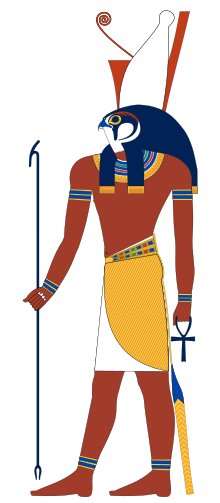
Horus is probably most well-known as the protector of the ruler of Egypt. The Egyptians believed that the pharaoh was the 'living Horus'. The ancient Egyptians had many different beliefs about the god Horus. One of the most common beliefs was that Horus was the son of Isis and Osiris. After Osiris was murdered by his brother Set(or Seth), Horus fought with Set for the throne of Egypt. In this battle, Horus lost one of his eyes. The eye was restored to him and it became a symbol of protection for the ancient Egyptians. After this battle, Horus was chosen to be the ruler of the world of the living.
The name Horus is Greek. In Ancient Egypt he was known as “Heru” (sometimes Hor or Har), which is translated as “the distant one” or “the one on high”(from the preposition “hr” meaning “upon” or “above”).
Horus seems to have begun as a god of war and a sky god who was married to Hathor, but soon became considered as the opponent of Set and later the son of Osiris. Horus and Set were always placed in opposition to each other. Set was the embodiment of disorder and chaos while Horus was the embodiment of order. Similarly, Horus represented the daytime sky while Set represented the night time sky.
Horus was also the patron of young men and was often described as the perfect example of the dutiful son who grows up to become a just man. However, this is perhaps debatable in the light of one of the stories concerning his fight with Set. The mother of Horus (Isis) was a great magician who most certainly had the power to destroy Set. However, when her chance came she could not take it. Set was, after all, her brother. This angered Horus so much that he chopped off his mother’s head in a fit of rage! Thankfully, Isis was more than able to handle this insult and immediately caused a cow’s head to grow from her neck to replace her head. Luckily for Horus, Isis was a compassionate and sympathetic goddess and she forgave her vengeful son his aggressive act.
6. Hathor: The protective goddess and the goddess of love and joy
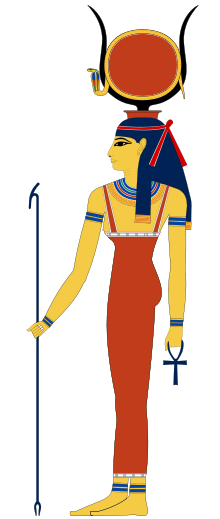
Hathor was the wife of Horus, and was sometimes thought of as the mother of the pharaoh. Hathor was connected with foreign places and materials. For instance, Hathor was the goddess of the desert and the turquoise mines in the Sinai.
Hathor is one of the most famous goddesses of Ancient Egypt. She was known as “the Great One of Many Names” and her titles and attributes are so numerous that she was important in every area of the life and death of the ancient Egyptians.
She was originally a personification of the Milky Way, which was considered to be the milk that flowed from the udders of a heavenly cow. She was a sky goddess, known as “Lady of Stars” and “Sovereign of Stars” and linked to Sirius. Her birthday was celebrated on the day that Sirius (天狼星) first rose in the sky.
However, she was also a goddess of destruction in her role as the Eye of Ra – defender of the sun god. According to legend, people started to criticise Ra when he ruled as Pharaoh. Ra decided to send his “eye” against them (in the form of Sekhmet). She began to slaughter people by the hundred. When Ra relented and asked her to stop she refused as she was in a blood lust. The only way to stop the slaughter was to colour beer red (to resemble blood) and pour the mixture over the killing fields. When she drank the beer, she became drunk and drowsy, and slept for three days. When she awoke with a hangover she had no taste for human flesh and mankind was saved. Ra renamed her Hathor and she became a goddess of love and happiness. As a result, soldiers also prayed to Hathor/Sekhmet to give them her strength and focus in battle.
7. Ra:the sun god
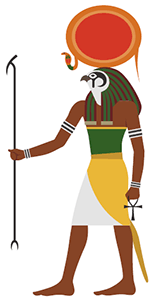
Ra was the most important god of the ancient Egyptians. The ancient Egyptians believed that Ra was swallowed every night by the sky goddess Nut, and was reborn every morning. The ancient Egyptians also believed that he travelled through the underworld at night. In the underworld, Ra appeared as a man with the head of a ram (an adult male sheep).
Ra was an ancient god, but not the oldest of the gods; the first references to Ra date from the Second Dynasty. However, by the Fifth Dynasty he was a powerful god who was closely associated with the pharaoh. The Pharaoh was already seen as the embodiment of Horus and so the two gods became linked, sometimes as the composite deity Ra-Horakhty (“Ra (is) Horus of the Horizon”). Ra also came to be associated with Atum (the creator god of the Ennead in Heliopolis) as Atum-Ra. By the Fifth Dynasty the pharaoh was referred to as the son of Ra and the name of Ra was incorporated into the throne name of every king from that point onwards. Many Old Kingdom pharaohs built sun temples in which to worship Ra.
8. Bastet: A protective goddess
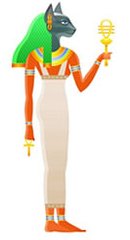
Bastet is a woman with the head of a cat. She was usually seen as a gentle protective goddess. She is generally thought of as a cat goddess. However, she originally had the head of a lion or a desert sand-cat and it was not until the New Kingdom that she became exclusively associated with the domesticated cat. However, even then she remained true to her origins and retained her war-like aspect. She personified the playfulness, grace, affection, and cunning of a cat as well as the fierce power of a lioness.
As the daughter of Ra she was one of the goddesses known as the “Eye of Ra”, a fierce protector who almost destroyed mankind but was tricked with blood-coloured beer which put her to sleep and gave her a hangover, stopping the carnage. As a result, she is linked to the other goddesses who were known as the “eye of Ra”, most notably Sekhmet, Hathor, Tefnut, Nut, Wadjet and Mut.
